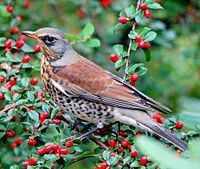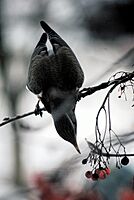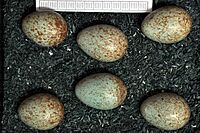Fieldfare facts for kids
Quick facts for kids Fieldfare |
|
|---|---|
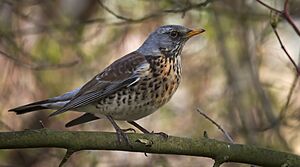 |
|
| Conservation status | |
| Scientific classification | |
| Genus: |
Turdus
|
| Species: |
pilaris
|
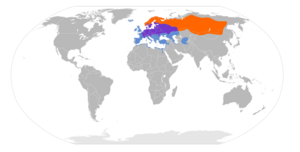 |
|
| Nonbreeding Breeding Year-round | |
The fieldfare (Turdus pilaris) is a type of bird in the thrush family. These birds live in woodlands and scrub areas in northern Europe and across Asia. Fieldfares are known for being very migratory, meaning many of them fly south for the winter.
While they rarely breed in Great Britain and Ireland, huge numbers of fieldfares spend their winters in the United Kingdom, Southern Europe, North Africa, and the Middle East. Fieldfares eat many different things. In summer, they enjoy molluscs, insects, and earthworms. In winter, they switch to berries, grains, and seeds.
Fieldfares often build their nests close to each other in small groups. This might help protect them from predators. They build their nests in trees and lay about five or six eggs. Both parents feed the baby birds, called chicks, until they are ready to leave the nest after about two weeks. In warmer areas, fieldfares might have two sets of chicks in a year, but only one in colder regions. When they migrate or during winter, fieldfares often fly in large groups, sometimes with redwings.
A fieldfare is about 25 centimeters (10 inches) long. It has a grey head, neck, and rump, with a plain brown back. Its wings and tail are dark, and its underwings are white. The chest and sides are covered in many spots. The chest has a reddish tint, and the rest of its underside is white. Males and females look similar, but females are a bit browner. Male fieldfares have a simple chattering song, and they make different loud calls when flying or when they sense danger.
Contents
What is a Fieldfare?
Nearly 90 types of medium to large thrushes belong to the Turdus group. These birds usually have round heads, long, pointed wings, and often sing beautiful songs. The fieldfare is a thrush that came to Europe from ancestors who had first settled in the Caribbean islands.
Naming the Fieldfare
The Swedish scientist Carl Linnaeus first described the fieldfare in 1758. He gave it its scientific name, Turdus pilaris. Both parts of this name come from Latin words for "thrush." There are no different types or subspecies of fieldfare recognized.
The English name "fieldfare" has been used for a very long time, since at least the 11th century. The old English word for it might have meant "traveller through the fields." Some people also think it could mean "grey piglet," which is similar to an old Welsh name for the bird.
What Does a Fieldfare Look Like?
The fieldfare is easy to spot! It has a grey head, neck, and rump, a dark brown back, and a blackish tail. Its chest is covered in bold speckles. When it flies, you can clearly see its white underwings. Its loud "tsak tsak" call during flight is also very special.
Male fieldfares have a bluish-grey forehead and crown, with a brownish-black stripe on each feather. The areas around their eyes are black, and they have faint, light streaks above their eyes. Their cheeks, neck, and rump are bluish-grey. Their back feathers are dark chestnut-brown with dark stripes. The tail feathers are brownish-black.
The chin, throat, and upper chest are creamy-buff with strong brownish-black streaks and spots. The lower chest and belly are creamy-white with fewer spots. The main wing feathers are brownish-black. The underwing feathers are white. The beak is strong and slightly curved. In winter, it's orange-yellow with brownish-black tips. In summer, the male's beak turns yellow. Their eyes are dark brown, and their legs and feet are brown. An adult fieldfare is about 25 cm (10 inches) long. Its wingspan is about 39 to 42 cm (15 to 16.5 inches), and it weighs between 80 and 140 grams (2.8 to 4.9 ounces).
Female fieldfares look very much like males. However, their upper parts are a bit browner, and the black stripes on their crown feathers are thinner. Their throat and chest are lighter with fewer, smaller marks. Young fieldfares are duller in color than adults. They have light streaks on feathers that are dark in adults. They get their adult feathers after their first molt in the autumn.
Fieldfare Calls and Songs
The fieldfare's main call is a harsh "tsak tsak tsuk," usually heard when it's flying. When birds gather in trees, they make a softer version of this sound, like they are chatting. If they are angry or scared, they make different warning sounds, similar to the mistle thrush.
Male fieldfares have a rather weak song during the breeding season. It's a mix of short phrases, like those of the common blackbird, mixed with whistles, guttural squeaks, and call notes. They sing this song while flying or from a tree. A quieter version of this song, with more warbling notes, is sung by groups of birds when they gather to roost at night.
Where Do Fieldfares Live?
The fieldfare is a migratory bird found across Europe and Asia. They breed in northern countries like Norway, Sweden, Finland, and across Siberia. In winter, they fly south to western and southern Europe, and even North Africa. Some eastern groups travel to Turkey, Lebanon, Iran, and parts of India. Sometimes, they are seen in places like Iceland or the United States, but this is rare.
Fieldfares fly slowly and directly. They beat their wings strongly a few times, then glide briefly before flapping again. In winter, they are very social and often gather in groups. They can be quite shy and easily scared then. However, during the breeding season, they become bold and noisy. When a group is in a tree, they often all face the same way and chatter constantly.
When they look for food on the ground, often with redwings, the group moves against the wind. Each bird stops now and then to stand tall and look around before eating again. If they get scared, they fly away downwind, and the group forms again somewhere else. In woodlands, they don't hide in the bushes like blackbirds. Instead, they perch openly on bushes and high branches. They often roost together, sometimes in overgrown hedges or bushes, but usually on the ground in grassy areas or young tree plantations.
Fieldfare Homes
In summer, fieldfares prefer mixed woodlands with trees like birch, pine, and spruce. They often live near marshes or open moorland. They don't mind being near people and can be found in farms, orchards, parks, and gardens. They also live in open tundra and on hillsides above the tree line.
In winter, groups of fieldfares are mostly found in open areas, farmlands, orchards, and open woodlands. They travel around, looking for places with lots of berries and insects. Later in winter, they move to pastures and cultivated fields.
Fieldfare Journeys
Fieldfares start their migration south from their breeding areas in October. However, most of them arrive in the United Kingdom in November. Some of these birds keep flying further into continental Europe, but others stay. The birds that were just passing through return in April, and most of the fieldfares leave the United Kingdom by early May.
How Fieldfares Live
What Fieldfares Eat
Fieldfares are omnivores, meaning they eat both plants and animals. Their animal diet includes snails, slugs, earthworms, spiders, and insects like beetles and their young, flies, and grasshoppers.
When berries become ripe in autumn, fieldfares eat a lot of them. They especially love berries from hawthorn, holly, rowan, yew, juniper, and dog rose plants. Later in winter, they eat apples that have fallen from trees, and they might even eat root vegetables like swedes in fields. They also eat grain and seeds. If food becomes scarce, or during very cold weather, they might go to marshes or even the seashore to find molluscs.
Fieldfare Reproduction
The breeding season for fieldfares starts in May in places like Poland. Further north in Scandinavia, it might not begin until early July. The female fieldfare builds a cup-shaped nest. She doesn't try to hide it much. Nests are often in woodlands, but can also be in hedges, gardens, among rocks, in log piles, or even on the ground.
Fieldfares usually nest close to other fieldfares. The adult birds will fiercely defend their nest. Nesting in groups might help protect them from predators. The nest is made of dried grasses and weeds, with some twigs and moss. It has a lining of mud and an inner lining of fine grasses.
A female usually lays five or six eggs, but sometimes as few as three or as many as eight. The eggs vary in size and color. Many are pale blue with small brown dots, looking like those of the common blackbird. Others are bright blue, sometimes with larger red-brown spots. The female does most or all of the incubation, which means sitting on the eggs to keep them warm. This lasts for thirteen to fourteen days.
The chicks are born helpless and need a lot of care. Both parents bring food to them. They are usually ready to leave the nest after fourteen to sixteen days. Fieldfares might have two sets of chicks in a season, especially in the warmer, southern parts of their breeding range.
Protecting Fieldfares
The fieldfare lives across a very large area, estimated to be about 10 million square kilometers (3.8 million square miles). It also has a very large population. In Europe alone, there are thought to be between 42 and 72 million fieldfares. The total number of fieldfares in the world is estimated to be between 44 and 96 million.
The number of fieldfares seems to be stable. The bird is not considered to be at risk of disappearing. Because of this, it is listed as a species of "least concern" by the IUCN Red List of Threatened Species. This means it is not currently facing a high risk of extinction.
In the United Kingdom, where only a few pairs of fieldfares breed, it is classified as a Red List species by the RSPB (Royal Society for the Protection of Birds) as of January 2013. This is because it is so rare as a breeding bird there.




